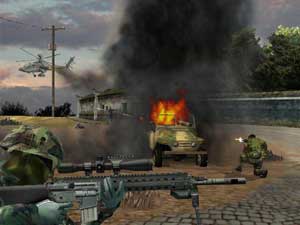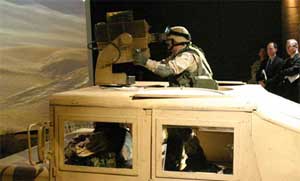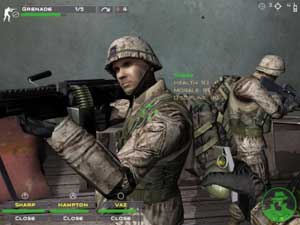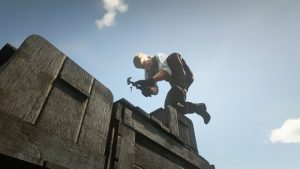Day one of Game, Set and Match II in Delft has been hugely satisfying. Will never ever find the time to blog everything i’ve heard but here’s a first one:
First Person Paradoxes: The Logic of War in Computer Games by David Nieborg, from the University of Amsterdam.
Most digital games revolve around direct or indirect conflicts. War has therefore always been an easy pick for game designers. This presentation focussed on”realistic” SQUAD-BASED online multiplayer First Person Shooter pc games. They are squad-based (on the one hand the terrorists, on the other one the counter-terrorists). They involve some tactics (that’s what makes them realistic). Examples: America’s Army, Battlefield 2, Counter Strike and the recent Ghost Recon (image below) which features the highest tech that the U.S. army actually has at its disposal.

“Winning is keeping the target in constant sight”, wrote Virilio. The battlefield has always been a question of perception: seeing is killing. That’s why the U.S. military is so good at developing gears that enable soldiers to see better in whatever condition.
Are FPS games “murder simulators” (according to critics and academics) or “training tools” (for the U.S. military?
1999 Dave Grossman, Stop Teaching Our Kids To Kill
versus
Herz & Macedonia, Computer Game and the Military. Two Views, an article published in Defense Horizon in 2002.
The game industry and the U.S. military can benefit from each other.
Context:
1. The military entertainment context. The connection between military and entertainment go beyond gaming: movies supported by military, cooperation with military to develop games, TV series, sponsoring of game events, etc.
Through the appropriation and adaptation of successful commercial game technology, the military taps directly into youth popular culture.
e.g. Full Spectrum Warrior 04 developed as a training tool for the U.S. army but available in the shops.
Close Combat, a training for marines available in shops as well.
Military wants to incorporate more youngsters.
Warlords, a LAN party for fun.

JFETS (Joint Fires and Effects Trainer System, image above) developed with the help of Hollywood special effect experts. Increasing blurring of the entertainment and the industry.
2. Ongoing military transformation context
– passing from C3 to C4 ISR: from Command, Control and Communication to Command, Control, Communication, Computer, Intelligence, Surveillance and Reconnaissance. War fought through an increased used of technology.
– Unmanned Aerial Vehicles
– robotisation.
Baudrillard in 91: When war has become information “it ceases to be war and becomes a virtual war”.
Analysis: FPSs as war games. The analysis of FPS games points to “first person paradoxes.” The static game space of multiplayer FPS maps do not correspond to the logic of war as it is fought now and in the future. The logic of war collide with the design of virtual battelfields resulting in two paradoxes.
1. Paradox of reductiveness
Every simulation involves some reduction of course.
Based on Luttwak’s Strategy: the Logic of War and Peace (2001), the five levels of strategy are:
– technical level: weapons,
– tactical,
– operational,
– theather (in the sense “the European theatre of operation”),
– grand strategy: diplomacy/politics.
The logic of FFFF (find, fix, fight and finish the enemy) governs FPS games. Most of these games only feature the two first levels of strategy, ex: Counter Strike and America’s Army. They only focus on the lowest levels of strategy and could therefore be labelled as abstract simulation of certain aspects of “real” war.
There are exceptions, Battlefield 2 has the operational level: a commandeur has a bird vision of the battlefield: he can send supply where needed, place artillery bombardments, etc.
Elements such as dying children, dullness of war (waiting for a battle), the rules of war (taking prisonners and interrogating them), the intrusion by journalists or NGOs… are conveniently absent in FPSs. Constant negociation between the goal to entertain and to offer an “authentic” experience.
 2. Paradox of fairness
2. Paradox of fairness
The modelling of the two teams fighting in online FPSs has made it impossible to emphasize the role of technology within the military. Weapons and gears are carefully balanced. e.g. the two fighting parties in America’s Army see themselves as U.S. soldiers and the other team as the opposing forces and both battle with weapons that have similar effects. Thus the paradox of fairness makes it impossible to simulate the (supposed) superiority of American soldiers.







